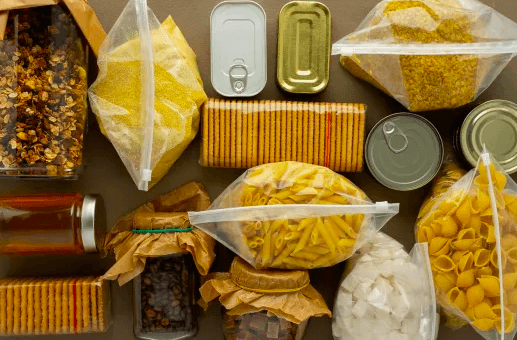Survival Food Essentials for Long-Term Emergency Preparedness

In a world where natural disasters, economic disruptions, and other unforeseen events can strike at any time, long-term emergency preparedness has become a crucial aspect of personal and family safety. One of the most vital components of a comprehensive preparedness plan is ensuring a reliable supply of survival food. Properly planning for long-term food storage can provide peace of mind and sustain you through extended emergencies. This article will explore the essentials of survival food for long-term preparedness, including key considerations for food selection, storage, and management.
Understanding Long-Term Emergency Food Needs
1. Assessing Your Food Requirements
Before diving into specific food items, it’s important to understand your long-term food needs. The average person requires about 2,000 to 2,500 calories per day to maintain their health and energy levels. For a family or group, you will need to calculate the total caloric needs based on the number of people and the duration of the emergency. Consider factors like age, activity level, and special dietary needs when planning your food supply.
2. Choosing Nutritionally Balanced Foods
A balanced diet is essential for maintaining health, especially during stressful and challenging times. Your survival food supply should include a variety of food groups to ensure you receive the necessary nutrients:
Proteins:
Essential for muscle repair, immune function, and overall health. Sources include canned meats, dried beans, lentils, and protein powders.
Carbohydrates:
Provide energy and should come from whole grains and starchy vegetables. Examples include rice, oats, pasta, and potatoes.
Fats:
Important for energy and cell function. Sources include cooking oils, nut butters, and canned fish.
Vitamins and Minerals:
Ensure you include fruits and vegetables, whether canned, freeze-dried, or in supplement form, to meet your vitamin and mineral needs.
Essential Survival Foods for Long-Term Storage
1. Canned Goods
Canned foods are a staple in long-term food storage due to their long shelf life and variety. Some key items include:
Canned Meats:
Tuna, chicken, beef, and turkey provide protein and can be used in various recipes.
Canned Vegetables and Fruits:
These are convenient sources of vitamins and minerals. Choose low-sodium options when possible.
Canned Soups and Stews:
Offer a convenient meal option with a mix of proteins, vegetables, and carbohydrates.
2. Freeze-Dried and Dehydrated Foods
Freeze-dried and dehydrated foods are lightweight, take up less space, and have a long shelf life. They are ideal for long-term storage:
Freeze-Dried Meals:
Pre-packaged meals that require only water to prepare. They are available in a variety of cuisines and flavors.
Dehydrated Fruits and Vegetables:
These retain most of their nutrients and are a good addition to meals or as snacks.
3. Grains and Staples
Grains and staples form the foundation of many meals and have a long shelf life:
Rice and Pasta:
Versatile and can be used as a base for many dishes. Store in airtight containers to prevent moisture and pests.
Oats and Flour:
Useful for baking and making breakfast dishes. Ensure they are stored in cool, dry conditions.
4. Legumes and Beans
Legumes and beans are excellent sources of protein, fiber, and essential nutrients:
Dried Beans and Lentils:
Have a long shelf life and can be cooked in a variety of ways. They are also relatively inexpensive.
Canned Beans:
Offer a quicker preparation option compared to dried beans.
5. High-Energy Foods
High-energy foods are important for maintaining stamina and energy levels:
Nut Butters:
Peanut butter and almond butter are nutrient-dense and provide fats and proteins.
Nuts and Seeds:
High in protein and healthy fats, they are also a good source of vitamins and minerals.
6. Dairy Alternatives
If fresh dairy is not an option, consider these alternatives:
Powdered Milk:
Can be reconstituted with water and used in cooking or drinking.
Shelf-Stable Milk:
Available in various forms, such as evaporated or ultra-high-temperature (UHT) milk.
Storage and Management of Survival Food
1. Proper Storage Techniques
To ensure the longevity and safety of your survival food, proper storage is crucial:
Temperature:
Store food in a cool, dry place. Ideally, keep temperatures below 70°F (21°C) to prevent spoilage and maintain quality.
Humidity:
Keep storage areas dry to prevent mold and mildew growth. Use desiccants or moisture absorbers if necessary.
Pests:
Protect food from pests by using airtight containers and inspecting food regularly for signs of contamination.
2. Rotation and Inventory Management
Implementing a rotation system helps ensure that you use older items first and reduce waste:
First In, First Out (FIFO):
Organize your food supply so that older items are used before newer ones. Label containers with expiration dates to track usage.
Regular Checks:
Periodically review your food inventory to ensure that items are within their shelf life and to restock as needed.
3. Water Storage and Purification
In addition to food, water is a critical component of emergency preparedness. Ensure you have a sufficient supply of potable water and consider water purification methods:
Water Storage:
Store water in food-grade containers and keep it in a cool, dark place.
Purification:
Use water filters, purification tablets, or boiling methods to ensure water is safe for consumption.
Preparing for Diverse Scenarios
1. Special Dietary Needs
Consider any special dietary requirements or restrictions within your household:
Allergies and Intolerances:
Ensure that your food supply accommodates any allergies or intolerances, such as gluten or dairy.
Medical Conditions:
If anyone in your household has specific medical conditions, such as diabetes, plan for foods that align with their dietary needs.
2. Cooking and Meal Preparation
Ensure you have the means to cook and prepare meals:
Cooking Equipment:
Store essential cooking tools, such as a portable stove or camping cookware, along with fuel sources.
Recipes and Instructions:
Keep recipes and instructions for preparing long-term storage foods, especially if they require special preparation methods.
Conclusion
Long-term emergency preparedness requires careful planning and thoughtful selection of survival food essentials. By understanding your food needs, choosing a variety of nutritionally balanced foods, and implementing proper storage and management techniques, you can ensure that you are well-prepared for extended emergencies. Building a robust food supply not only provides peace of mind but also contributes to your overall resilience and readiness in the face of unforeseen challenges. By incorporating these strategies into your preparedness plan, you can safeguard your health and well-being during times of crisis and ensure that you and your family remain well-nourished and secure.




